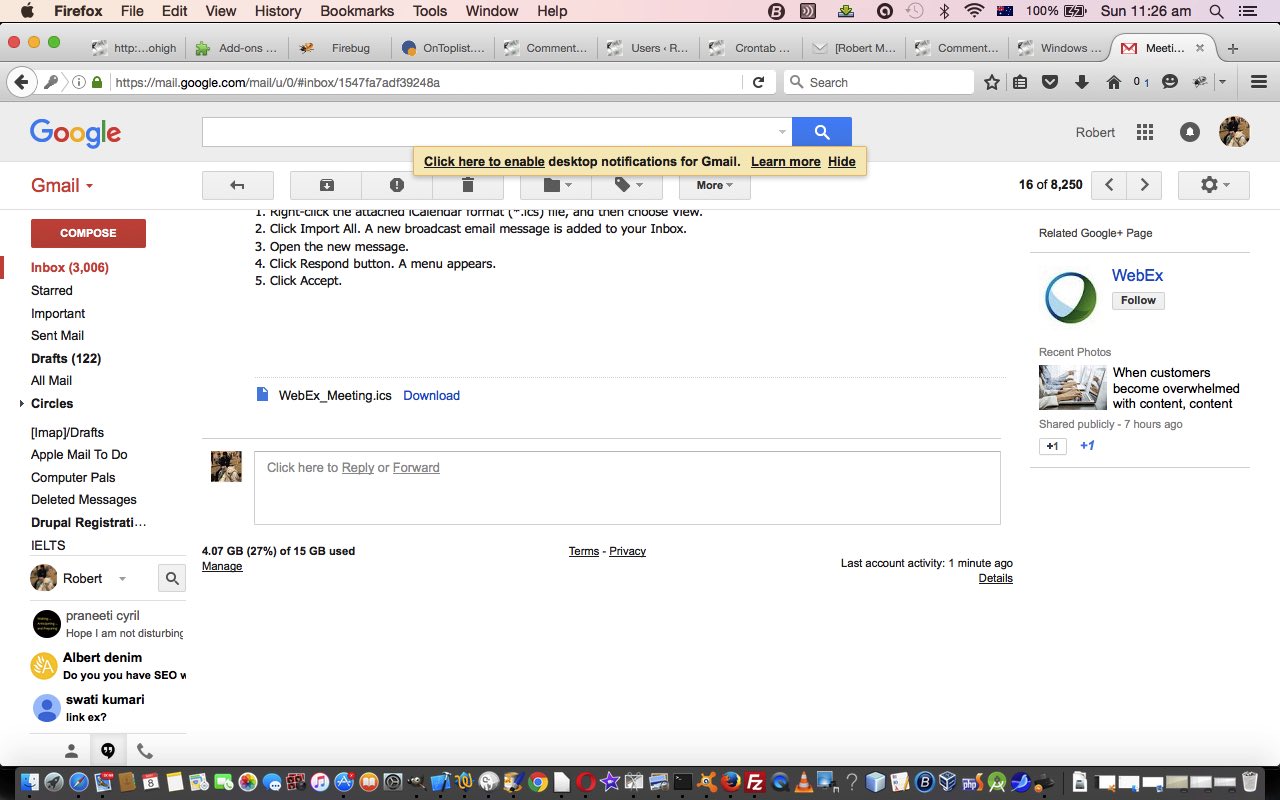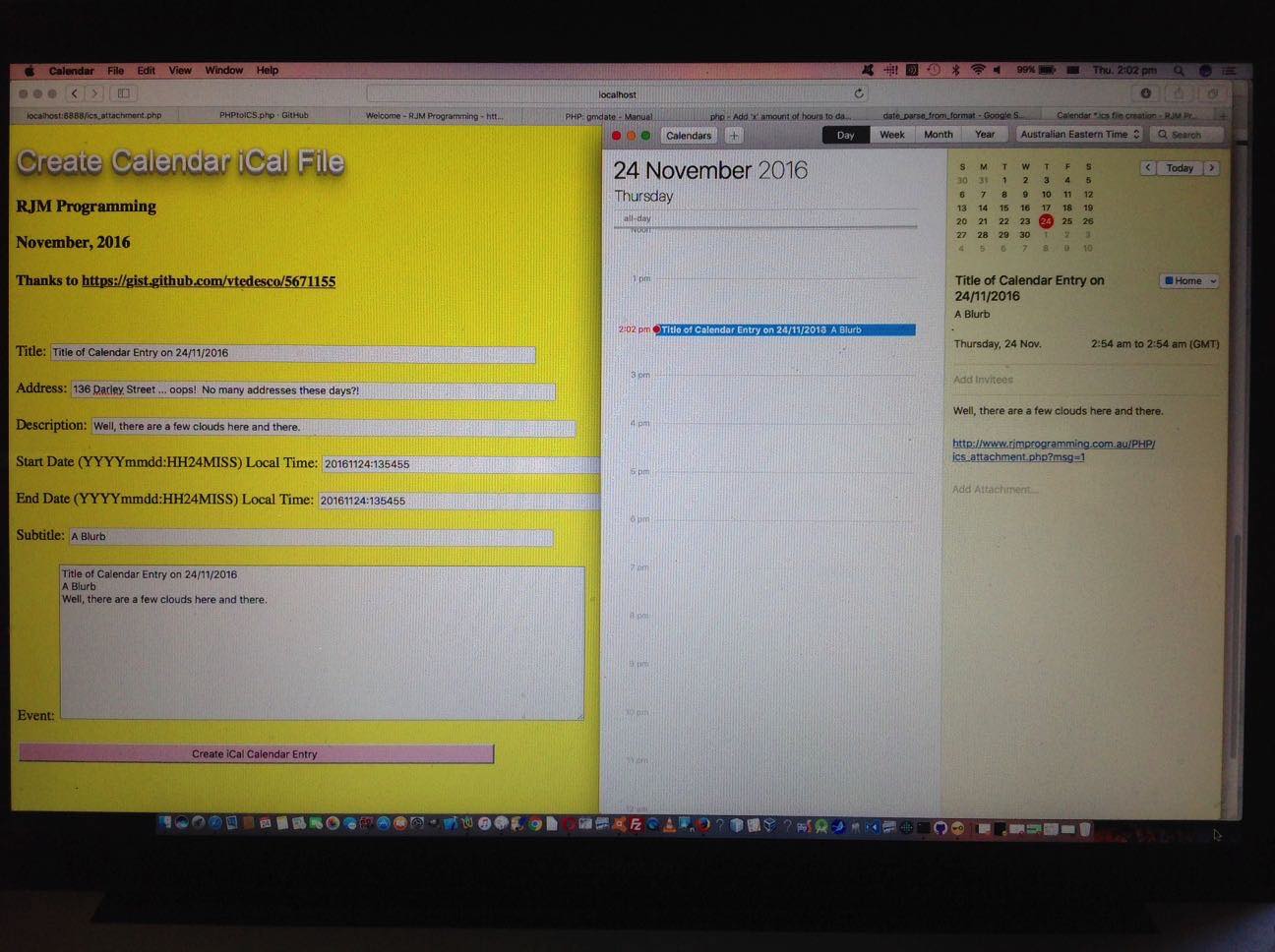Do you remember us talking about the ICS extension file when we presented WebEx Prerecording Primer Tutorial as shown below? It is an integration input to working with iCal Calendar software.
So here we are at a “when” of life tutorial, which is always an interesting exercise in our book. And “book” could be the go for an application to use this type of functionality. When you “book” something, you’d often want to remind yourself and/or others of such an event. But for now, we are concentrating on making a “tool” type of web application that will suit future purposes.
We’ve built a web application around the useful logic presented in this great Git repository today, writing our code in PHP, because you are dealing with header manipulation here centering around …
header('Content-type: text/calendar; charset=utf-8');
header('Content-Disposition: attachment; filename=rjmprogramming-event.ics');
echo $ical;
… where the PHP variable $ical contents has been pieced together in response to a callback from an earlier HTML form execution of the same ics_attachment.php code where the necessary details are collected off the user.
If you try the live run you’ll probably glean that most of our concern centered around the date and time, regarding timezone use so that we …
- in the HTML form execution we use client Javascript to glean the local timezone and local date and time to default the form appropriately … so that …
- in the HTML form execution the user fills out Calendar Event start and end times with respect to local time and this, along with an offset to get these times back to UTC or (Greenwich Mean Time) are passed to the callback web application (which is the same web application) … so that …
- the second callback execution constructs the iCal (for an rjmprogramming-event.ics attachment) with these UTC (or GMT) date and times in mind, whereby the “Z” timezone parameter fits the bill nicely … and when …
- the user saves this rjmprogramming-event.ics event into the iCal Calendar application, where the event will be shown back relative to the local date and time
The date and time functions used to make this happen are …
- Javascript’s Date object …
var dd=new Date();
var qw=eval((eval(dd.toTimeString().replace('-',' ').replace('+',' ').split(' ')[2]) - eval(dd.toTimeString().replace('-',' ').replace('+',' ').split(' ')[2] % 100)) / 100) + eval((0.0 + eval(dd.toTimeString().replace('-',' ').replace('+',' ').split(' ')[2] % 100)) / 60.0);
if (dd.toTimeString().indexOf('+') != -1) qw=-qw;
document.getElementById('tz').value=qw;
- Javascript’s Date object’s toTimeString method (as shown above) to glean the local timezone offset, and its opposite
- PHP’s DateTime object …
$di="PT" . str_replace("-","",urldecode($_POST['tz'])) . "H";
$parsed_date = DateTime::createFromFormat('Ymd:His', $ts);
if (strpos(urldecode($_POST['tz']), "-") !== false) {
$parsed_date->sub(new DateInterval($di));
} else {
$parsed_date->add(new DateInterval($di));
}
$outts = $parsed_date->format('Ymd:His');
- PHP’s DateTime object’s createFromFormat constructor method (as above) to create a DateTime object from the passed through user details
- PHP’s DateInterval object
- PHP’s DateTime object’s add and/or sub methods (as above) to create a DateTime object with a DateInterval offset to UTC (or GMT) (expressed in hours)
- PHP’s DateInterval object’s format method (as above) to end up with a UTC (or GMT) expression of date and time to be placed into the rjmprogramming-event.ics iCal message
We’ll probably be revisiting with improvements soon, but we hope you try it for yourself.
Previous relevant WebEx Prerecording Primer Tutorial is shown below.
We’ve been trying out WebEx (by Cisco) prerecording as a video conferencing idea as an alternative to …
- GoToMeeting (by Citrix) we talked about with GoToMeeting Primer Tutorial
- Skype (by Skype and now Microsoft) we talked about with Skype Primer Tutorial
… regarding video conferencing products we’ve tried at this blog.
Have to say, WebEx is great, even with respect to the “wide eyed and bushy tailed” reaction “this little black duck” has to all these networky communicaty ideas on the net (at least we spelt “net” correctly).
Have to thank my wife, Maree, for her expertise and the facilities her company, Thomson Reuters, supplies for the serving of WebEx recordings … thanks everyone. Have been assured they are periodically deleted, and my lame impersonations of the old “ducks on the wall” can rest in peace shortly.
And so, we have a slideshow starting with a WebEx email link to join a meeting, and we pan down the email to show you other WebEx functionalities, such as adding a Calendar reference to the meeting time, and though we haven’t shown you detail here, rest assured it handles timezone scenarios very well, unless you lie about living in Antarctica, that is … sorry, scientists in Antarctica reading this blog posting … all 237 of you.
During this “earlier than today exploration of WebEx” session the necessary software installs just happened for this MacBook Pro Mac OS X laptop as if we were shelling peas … it’s always good to have some handy when installing any software. So we won’t show you this unless we deem it essential at a later date. You can perhaps do as I did, and ask a real WebEx user invite you to a meeting, to set yourself up. In fact, today’s session meeting creation time you may notice is well in the past from that earlier introductory learning session Maree and I had, and you can bring back up that old email, and resurrect that meeting again and again, if you like … am not sure if there is an expiry date on this too, like with server stored WebEx prerecordings.
So also rest assured, WebEx handles …
- video via webcam on your device
- audio via microphone on your device (“Use Computer”) or via a phone line
- the synchronization of the two above
- mobile devices
Did you know?
A .ics extension file, as you can see being used as an email attachment file extension in  is, as explained in this link‘s sublink …
is, as explained in this link‘s sublink …
ICS is a global format for calendar files widely being utilized by various calendar and email programs including Google Calendar, Apple iCal, and Microsoft Outlook. These files enable users to share and publish information directly from their calendars over email or via uploading it to the world wide web.
… as helping interface meetings to online calendar appointments. Cute, huh?!
If this was interesting you may be interested in this too.
If this was interesting you may be interested in this too.




